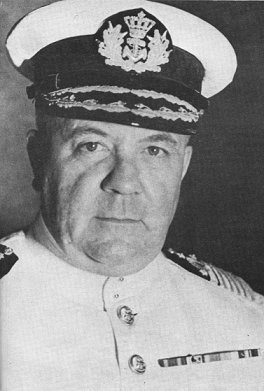![]()
Admiral C. E.L. Helfrich, RNN
![]()
Admiral Conrad Emil Lambert Helfrich Born Semarang, Java October 11, 1886 - Died The Hague, September 20, 1962 A much criticized person was Admiral Helfrich, who had been Commander-in-Chief of all Dutch naval forces in the Netherlands East Indies since October 1939. After Japan had attacked Pearl Harbor, the Dutch found
themselves at war with an old enemy, who had been after the rich natural resources of this Dutch colony
since the turn of the century. Since Holland was only a small country with limited resources, the Dutch could
never hope to defend their territory on their own; the assumption was that if tension in the Far East would
erupt in war, they could count on the British and the Americans for help. But unfortunately, neither the Americans nor the British could put up effective
resistance; in fact, the British had to call upon the Dutch for submarines and aircraft in the defence of Malaya
and Singapore. The successes that these forces scored, numerous in comparison to those by the British and Americans, earned
him the nickname "Ship-a-day" Helfrich in the American press. In January, the Allied nations agreed upon a combined command for all
national forces (ABDA-COMMAND), something which had been advocated by Helfrich on numerous occasions. Although the formation was a step in the good direction, Helfrich
was disgusted to learn that, although he retained command over local naval forces, he was shut out of any position which would allow him to influence strategic directives. Since the Japanese attack on Pearl Harbor, he advocated an offensive strategy, to keep the Japanese as far north as possible. It was not until mid-February, after political pressure by the British and Dutch governments, that he took over from Admiral Thomas Hart, USN, as Commander-in-Chief of all Allied naval forces in the Netherlands East Indies (designated ABDA-FLOAT). But by this time, the opportunities to take the offensive were long gone, and there was no hope to protect Java island against the Japanese invaders. A much criticized person was Admiral Helfrich, who had been Commander-in-Chief of all Dutch naval forces in the Netherlands East Indies since October 1939. After Japan had attacked Pearl Harbor, the Dutch found
themselves at war with an old enemy, who had been after the rich natural resources of this Dutch colony
since the turn of the century. Since Holland was only a small country with limited resources, the Dutch could
never hope to defend their territory on their own; the assumption was that if tension in the Far East would
erupt in war, they could count on the British and the Americans for help. But unfortunately, neither the Americans nor the British could put up effective
resistance; in fact, the British had to call upon the Dutch for submarines and aircraft in the defence of Malaya
and Singapore. The successes that these forces scored, numerous in comparison to those by the British and Americans, earned
him the nickname "Ship-a-day" Helfrich in the American press. In January, the Allied nations agreed upon a combined command for all
national forces (ABDA-COMMAND), something which had been advocated by Helfrich on numerous occasions. Although the formation was a step in the good direction, Helfrich
was disgusted to learn that, although he retained command over local naval forces, he was shut out of any position which would allow him to influence strategic directives. Since the Japanese attack on Pearl Harbor, he advocated an offensive strategy, to keep the Japanese as far north as possible. It was not until mid-February, after political pressure by the British and Dutch governments, that he took over from Admiral Thomas Hart, USN, as Commander-in-Chief of all Allied naval forces in the Netherlands East Indies (designated ABDA-FLOAT). But by this time, the opportunities to take the offensive were long gone, and there was no hope to protect Java island against the Japanese invaders.As a result of an order by the Combined Chiefs of Staff to stand and fight until the bitter end, he made a very controversial decision during this period. He ordered the Combined Striking Force, a scratch-collection of Allied warships which happened to be in the area, to fight for the survival of Java. This culminated in the tragic Battle of the Java Sea. During this battle and its aftermath, the bulk of the Allied force and hundreds of lives were lost, including that of its commander, Rear-Admiral K.W.F.M. Doorman, RNN. The order to stand and fight evoked much criticism from the American side; its positive influence on moral was not realized until much later. Helfrich escaped the NEI by flying boat when surrender was eminent, and became Commander-in-Chief of all Dutch forces in the Far East. This was in fact a "paper" command, he had, much to his frustration, no real control over the operational use of his officers and men. On behalf of the Kingdom of the Netherlands, Helfrich was present on the battleship USS Missouri to accept the Japanese surrender on September 2nd, 1945. Retired in January 1949, Helfrich published his two-volume memoirs during 1950. He remained active in politics for some time thereafter.
|
|||||||||||||||||||||||||||||||||||||||||||||||||||||||||||||||||||||||||||||||||
![]()
Sources
Klaassen/Van 't Haaff "Gedenkboek Adelborsten-opleiding te Willemsoord, 1854-1945"
Vice-Admiral H.A. van Foreest "Grote Winkler Prins Encyclopedia"
C.E.L. Helfrich "Memoires", 2 volumes
"Biografisch Woordenboek van Nederland", volume 2 (entry by Ph.M. Bosscher)
![]()
| Back | Home |